|
Scientists Identify New Risk Factors in Heart Disease
Scientists Identify New Risk Factors
By Lynn Yarris
|
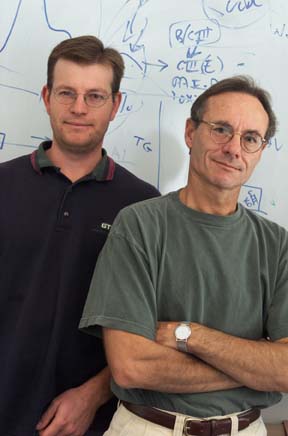 Edward Rubin (right), head of the Genome Sciences Department, and Len Pennacchio led the study that identified a new gene that influences triglyceride levels in mice and humans. |
Scientists using information from the Human Genome Project have identified a new apolipoprotein that appears to play a significant role in controlling triglyceride levels in the blood. Triglycerides are one of the two major blood fats, along with cholesterol, that are important risk factors in the development of heart disease.
Edward Rubin, who heads the Genome Sciences Department in Berkeley Lab’s Life Sciences Division, and Len Pennacchio, an Alexander Hollaender Distinguished Fellow working in Rubin’s research group, led a study in which the new gene — named apoAV — was identified by comparing the DNA sequences of humans and mice. ApoAV’s function was tested first in genetically engineered mice, then in human clinical studies, and shown to significantly influence triglyceride levels in both mammals.
“By comparing the sequence of the genomes of humans and mice we have found a genetic jewel that had been missed when the sequence of the human genome alone was analyzed,” says Rubin. “ApoAV appears to have a major role in lipid metabolism in both humans and mice.”
The results of this study have been published in the Oct. 5, 2001 issue of Science. Coauthoring the Science paper with Rubin and Pennacchio were Ron Krauss, also with Berkeley Lab, Michael Olivier and David Cox of Stanford University’s Human Genome Center, Jaroslav Hubacek and Jonathan Cohen of the University of Texas’ Southwestern Medical Center, and Jean-Charles Fruchart of the Pasteur Institute in Lille, France.
Heart disease remains the leading cause of death in the United States, and the majority of these deaths are the result of atherosclerosis — the hardening of arteries. Arterial hardening is caused by the rate at which plaque accumulates. This rate is accelerated when an individual has high cholesterol and triglyceride levels.
It is well-established that a cluster of apolipoprotein genes along human chromosome 11 — known as the apoAI/CIII/ AIV region — has a major influence on plasma lipid profiles and, consequently, atherosclerosis susceptibility. It is also well-known that mutations in DNA sequences within this region can contribute to severely elevated triglyceride levels. Since the DNA for the apoAI/CIII/AIV region has now been fully sequenced as a result of the Human Genome Project, Rubin, Pennacchio and their colleagues searched for additional functional elements around the region by looking for any sequences that had been conserved through evolution in both humans and mice.
Explains Rubin, “The approach we took was based on the concept that if a segment of the human and mouse genomes has been conserved over the 60 to 80 million years that have elapsed since these two organisms are believed to have diverged from a common ancestor, then the sequence within the segment probably encodes an important biological function. Accordingly, in scanning the genomes of mice and humans we focused our attention specifically on those sequences shared by humans and mice.”
Adds Pennacchio, “The availability of sequences within this region of the human genome led us to sequence the corresponding region of mouse DNA to compare the two. Through this analysis we found a large evolutionarily conserved sequence that was the next door neighbor to the apoAI/CIII/AIV region.”
This candidate human gene, which Rubin and Pennacchio dubbed “apoAV,” was introduced into a line of mice through standard transgenic technology and engineered to over-express itself. Using gene “knockout” technology, they also engineered mice that lacked apoAV. Comparing the two groups revealed a dramatic contrast.
“Mice with increased expression of apoAV (the ApoAV transgenics) showed a 70 percent decrease in plasma triglyceride concentrations, while mice lacking apoAV (the apoAV knockouts) showed a 400 percent increase,” says Pennacchio. “Sometimes when you do mouse studies, the knockout results will contradict results from the transgenic studies. In this case, the results from the two studies strongly supported one another.”
Having discovered the apoAV gene and shown that it influences triglyceride concentrations in mice, the researchers next examined the relationship between the human apoAV gene and plasma lipid levels.
“To see whether there was any connection between what we had seen in mice and the normal role of this gene in humans, we carried out two large clinical studies,” says Pennacchio. “In the first study we looked at 500 random Caucasians who had been examined for multiple different lipid parameters. In the second study we looked for these same common sequence variations in a different group of 400 individuals with extremely high and extremely low triglyceride levels. In both studies, a strong link was found between plasma triglyceride levels and particular sequence variations within and surrounding the apoAV gene.”
Says Rubin, “The two human studies indicated that a common sequence variation in the vicinity of apoAV that is present in more than 10 percent of the population results in a 20 to 30 percent increase in an individual’s blood triglyceride levels. With an individual’s triglyceride level being an important atherosclerosis susceptibility risk factor, this finding — especially if confirmed in follow-up studies — should be extremely relevant to a large number of people.”
In the Science paper, the researchers conclude that it may be possible to use apoAV polymorphisms as prognostic indicators for hyper-triglyceridemia susceptibility and that apoAV modulation could be a potential strategy to reduce this cardiovascular disease risk factor.
The next step, they say, will be to look into the mechanism by which apoAV polymorphisms influence triglyceride levels and try to identify the specific DNA sequence changes that lead to lower apoAV protein concentrations in the blood.
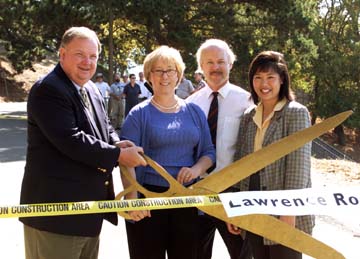 Preparing to cut the tape officially opening Lawrence Road to two-way traffic on Monday were Lab Director Charles Shank, Deputy Director Sally Benson, project manager Steve Blair, and Laura Chen, chief planner for Facilities. Not pictured is Mike Chartock, the director for planning and strategic development, whom Director Shank credited with championing the road adjustment over the last several years, thus enabling broader laboratory access. For a map and more information about parking in the area. See Parking Changes |
By Sally Benson
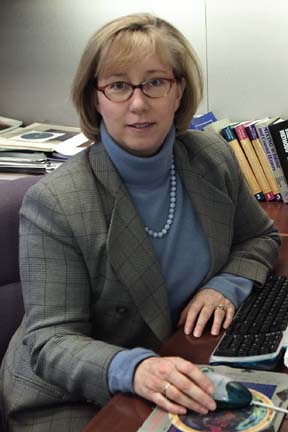 |
This is the time of the year when salary increases and compensation are foremost on the minds of many of us. While on our minds, I want to explain our compensation philosophy and describe a recent initiative we have undertaken to ensure that salary management at Berkeley Lab is competitive, fair, and promotes the excellence that is the hallmark of our laboratory.
Salary management at Berkeley Lab is based on three basic principles:
About a year and a half ago, our Human Resources staff embarked upon a market validation initiative — an ambitious effort to reevaluate whether or not our pay program is truly competitive with the market. The analysis began with scientists and engineers and proceeded through engineering; computing sciences; environment, health and safety; administrative services; financial services; and human resources. In the coming year, this effort will review the remaining job families. The market validation study made extensive use of industry-wide surveys that we believe provide accurate information, for all of our job families, about what our market is, both locally and nationally.
From the market validation study, two important issues were apparent. First, we found that our competitiveness with the market was uneven; some job families were very competitive, but others lagged the market. In the areas where we lag the market, we have been and will continue to improve the competitiveness of our compensation program.
We also found that some of our job families in the administrative departments and operations divisions were out of date. Some job families that made sense 10 years ago were no longer relevant. Job titles in some cases didn’t adequately reflect the nature and responsibility of the work. To address this issue, we engaged a contractor (Watson and Wyatt) to help us assess and redefine our job families at Berkeley Lab and to map current positions into the new job structure. Positions were redefined, mapped to redefined job families, and then compared to similar functions in our market surveys.
Over the next couple of weeks, our Human Resources Department will be supporting Division and Department management in communicating the details of these changes to all of us.
While I believe that the “market validation” initiative has allowed us to make great progress in improving salary management at Berkeley Lab, this doesn’t mean we’ve finished improving our compensation program. In addition to completing and continuing to respond to market assessments, we have new plans as well. Over the coming months we will be evaluating and improving the P2R process, with the goal of providing more meaningful feedback and increasing attention to employee development. It’s all part of our continuing efforts to keep Berkeley Lab thriving and make working here a positive and rewarding experience.
By Jon Bashor
Scientists at universities and national laboratories across the country are now tapping into the power of the world’s largest supercomputer dedicated to unclassified research and have reported important breakthroughs in climate research, materials science and astrophysics.
Berkeley Lab’s National Energy Research Scientific Computing Center (NERSC) has opened its newest supercomputer — a 3,328-processor IBM RS/6000 SP system — to more than 2,000 researchers nationwide. Named “GSeaborg” in honor of Nobel Laureate Glenn Seaborg, the system is capable of performing 5 trillion calculations per second (5 teraflop/s).
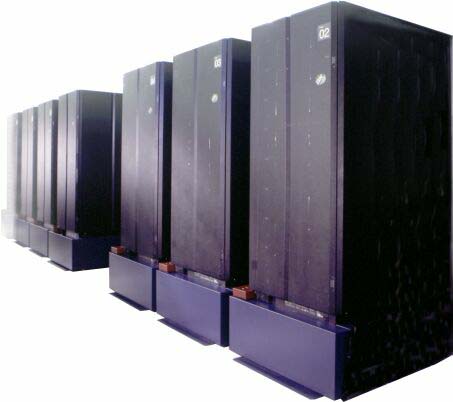 |
“Until now, this level of computing power simply has not been available to support research across a broad range of computational science,” said Lab Director Charles Shank. “As of today, however, scientists who are researching global climate change, exploring how to cut pollution from internal combustion engines, designing power sources for the future and finding new ways to treat disease have a much more powerful tool at their disposal. We fully expect this research to help shape how we live in the future.”
Located in the Lab’s Oakland Scientific Facility, the new IBM SP boasts the computing power of more than one million PCs, all able to work together to tackle some of the world’s toughest scientific problems.
After thorough testing, the IBM was opened to DOE’s research community in late August. Soon afterward, scientists around the country began using it to study complex problems.
“Serving up a lot of computing horsepower is only part of the computational science equation,” said Horst Simon, director of NERSC. “The real measure of our success as a supercomputing center is the level of science our research community is able to achieve using our resources. We’re very excited by the results already being reported and are looking forward to even greater accomplishments.”
The nature of the universe
A team of scientists at the University of Georgia, Berkeley Lab and the University of Oklahoma has been using the IBM to study several astrophysics problems. Peter Hauschildt of the University of Georgia analyzed observations of very low mass stars and “brown dwarf” extrasolar planets. His advanced model grids, which would have taken several months to run on smaller computers, were completed in just four days — and he was able to run up to 20 models at the same time as well.
Fellow researcher Eddie Baron of the University of Oklahoma ran numerous models of Type IIP supernovae, which will be very useful in the study of the extragalatic distance scale and the nature of the dark energy. The dark energy was discovered using Type Ia supernovae by the Berkeley Lab-based Supernova Cosmology Project and the High-Z Supernova Search Team, the two international groups of astronomers and physicists who discovered the accelerating expansion of the universe. This unknown energy, thought to make up about two thirds of the denisity of the universe, acts to overcome gravity and can be verified independently by the use of Type II supernovae, which Baron calculated by using the new machine. He said the models ran up to four times faster than on previous supercomputers.
High-res global climate modeling
Phil Duffy of the Climate and Carbon Cycle Modeling Group at Lawrence Livermore National Laboratory reported that his group used NERSC’s IBM SP to run a global climate change simulation at the highest spatial resolution ever used for such a simulation, making the model more useful for studying regional climate change.
Global climate simulations are typically performed on a latitude-longitude grid, with grid cell sizes of about 300 kilometers. Although such simulations can provide useful information on continental and larger scales, they cannot provide meaningful information on regional scales, such as for the state of California, Duffy said.
“Thus, coarse-resolution global climate simulations cannot provide information on many of the most important societal impacts of climate change, such as impacts on water resource management, agriculture, human health, etc.,” Duffy said. “To do this would require simulations with much finer spatial resolution. Using NERSC’s new IBM, as well as supercomputers at Lawrence Livermore National Lab, we have been experimenting with running global climate simulations at 50 km resolution. This is finer resolution than has ever been attempted in a global climate calculation.”
Compared to a typical global climate simulation, this simulation has 32 times more grid cells and takes up to 200 times longer to run on a computer.
Faster climate modeling
Computational scientists at the National Center for Atmospheric Research in Boulder, Colorado, are also using the NERSC IBM to run climate simulations at high speeds. Their goal is to demonstrate that a climate simulation spanning 100 years can be completed within a single day on a high-performance computer such as the IBM SP. This represents a ten-fold increase in speed over the current rate, and, the group says, “it would represent a major advance in geophysical fluid dynamics.” Using the NERSC IBM supercomputer, the team demonstrated that the dynamical core of an atmospheric general circulation model can be integrated at a rate of 130 years per day. Future work will include high speed modeling of processes such as precipitation and solar radiation, critical for simulations of the Earth climate system. Such a complete model would also couple the atmospheric component to ocean, ice and land surface models, all of which require massive computing power.
Better understanding of magnetic forces
As part of the extensive testing of the IBM SP system, a DOE research team of scientists from Berkeley Lab, Oak Ridge National Laboratory, and the Pittsburgh Supercomputing Center used the supercomputer to perform first-principles spin dynamics simulations of the magnetic structure of iron-manganese/cobalt interfaces. These large-scale quantum mechanical simulations reveal details that could not be obtained by any other means. This work is of fundamental importance to improving magnetic multi-layer computer storage and read-head devices. Using the IBM SP, the team achieved a maximum execution rate of 2.46 teraflop/s, one of the highest levels ever for a code producing significant scientific results.
In response to the terrorist attack on the World Trade Center, the U.S. Department of Energy and nearby national laboratories heeded New York City’s call for help. DOE contributed equipment, emergency medical technicians and other assistance in support of rescue efforts. Brookhaven National Laboratory dispatched fire department personnel, all trained in confined-space rescue, as well as truck and heavy rescue equipment and several electrical generators. The Princeton Plasma Physics Laboratory sent emergency services officers to the Meadowlands Complex in East Rutherford, New Jersey, to work in the triage area.
“Department of Energy personnel, like so many others throughout the nation, wanted to offer whatever help they could to try to ease the suffering in New York,” said Secretary of Energy Spencer Abraham. “DOE teams are working side by side with other Americans to provide whatever assistance we can and as soon as we can, to help New York overcome this terrible tragedy.”
Pennsylvania Governor Tom Ridge, appointed to head the newly created Office of Homeland Security, is being urged by lawmakers from California and New Mexico to make better use of the scientific and technological expertise at the national laboratories.
“Efforts to improve our homeland security should also focus on making better use of existing resources, such as those at our national labs,” said Rep. Ellen Tauscher (D-Calif) in a statement released last week by her office. Tauscher, whose district includes Lawrence Livermore National Laboratory, is vice chairman of the organization and a member of the House Democratic Caucus’ Task Force on Homeland Security.
Though Tauscher and other lawmakers specifically cited the weapons laboratories in their public statements, non weapons national laboratories, including Berkeley Lab, are exploring technologies that could be useful. For example, as reported in the Contra Costa Times, researchers in the Energy and Environmental Technologies Division are using sophisticated computer models to study how chemical or biological agents would flow through buildings in the case of an attack. — Lynn Yarris
The federal government is currently operating under a continuing resolution that provides the Fiscal Year 2001 existing level of funding to all federal activities through October 16. No new activities anticipated in the FY 2002 budget are allowed to begin during the period of the resolution.
Negotiations are underway to finish the 13 appropriations bills as soon as possible.
|
|
Over the past two month, the Lab welcomed a wide range of VIPs, both national and international, interested in the scientific work being conducted here. Clockwise are: Congressperson Lynn Woolsey of the sixth Congressional District, shown here speaking with Director Charles Shank and Division Director Daniel Chemla at the ALS; Oakland Vice Mayor Jane Brunner; David Garman of the DOE with Michael Siminovich in the Lighting Lab; and a delegation from Taiwan, also at the ALS.
|
|
The Laboratory has begun its recruitment for a Director of Public Affairs, a position created as part of a reorganization announced by Director Charles Shank in July.
The new director, a member of the senior management team, will head a more integrated, collaborative public outreach program to develop strong community partnerships for Berkeley Lab. The functions within public information, government and community relations, and science education are now collectively known as Public Affairs. The changes were made after a year-long evaluation.
Reporting to Director Shank, the new position has the responsibility to define, articulate and develop the public affairs strategy, policy, procedures and practices in support of the overall Laboratory vision and philosophy of conducting world-class science. The information and publications projects serve national, local, international, and Laboratory audiences.
Qualifications for the new position include executive experience with a proven background in public affairs in organizations with corporate and field operations. At least seven years is preferred at senior levels in large, diverse, complex organizations. The experience should include national and local media interaction; leadership over programs charged with building relationships with a variety of stakeholders and the public; and knowledge of science and technology programs and issues.
The search committee includes chairman David McGraw, currently acting director for Public Affairs and division director for Environment, Health and Safety; Deputy Directors Sally Benson and Pier Oddone, Associate Laboratory Director Bill McCurdy, Physics Division Director Jim Siegrist, Life Sciences Division Director Mina Bissell, and Director for Planning and Strategic Development Mike Chartock.
The complete position description and instructions on how to apply can be found on the web at http://cjo.lbl.gov/. Application reviews will be completed in October. — Ron Kolb
Roger O. Bangerter, recently retired as leader of the heavy ion fusion (HIF) group at Berkeley Lab and director of the HIF Virtual National Laboratory, was presented with a distinguished career award from Fusion Power Associates. Its board of directors honored Bangerter for “his many scientific contributions and the leadership and vision he has provided to the development of the heavy ion approach to inertial confinement fusion.”
The award has been presented annually since 1987 to individuals, at or beyond retirement age, who have made distinguished lifelong career contributions to fusion development. For a list of previous award recipients, see the FPA home page (//fusionpower.org) and click on “Awards.”
Priscilla Cooper, head of the Cell and Molecular Biology Department in the Life Sciences Division, and her co-principal investigator John Tainer were recently awarded a five year, $18.87 million program project grant from the National Institutes of Health, National Cancer Institute for research on the structural cell biology of DNA repair machines.
The program, which originally took shape in 1998 with an LDRD investment, involves 11 other institutions and a total of 18 senior investigators, with three cores projects and several subprojects to be centered at Berkeley Lab. The initial LDRD investment also resulted in an award of $4.5 million in DOE funding in October 2000 for the design and construction of the SIBYLS (Structurally Integrated BiologY for Life Sciences) beamline at the ALS. SIBYLS will be dedicated to the structural elucidation of molecular machines, with emphasis on multiprotein complexes involved in the five major DNA repair processes that are the focus of the new NIH program project. Defining these interactions and conformational changes will provide insights into the causes of increased susceptibility to DNA damage, and thus cancer predisposition.
Never before has so much been known about our bodies and the molecular mechanics that dictate their function — yet so little is known about why we become old. How can we maintain good health and postpone or even reverse old age and its debilitating diseases? In other words, how can we preserve youthfulness later in life?
Berkeley Lab, UC Berkeley and the Buck Institute for Age Research will host a day of discussions on these intriguing questions at the “New Science of Aging: A Symposium and Fair,” to be held Saturday, Oct. 20. This free event will be held from 10 a.m. till 5:30 p.m. in the Valley Life Sciences Building, Room 2040 on campus. Featured will be lectures by prominent gerontologists and industry scientists. In addition, several biotechnology companies and research institutions will provide information about their aging research programs and discuss collaboration and employment opportunities. A reception will follow.
The Symposium is sponsored by the University of California, the Biotechnology Strategic Targets for Alliances in Research (BioStar) Program, the UC Berkeley Center on Aging, Academic Geriatric Resource Program (AGRP), the UC Berkeley Retirement Center, and Biotime, Inc.
For a full agenda of the day’s speakers or to register, see http://crea.berkeley.edu/.
Employees who were on Laboratory travel and unable to return home as scheduled as a result of transportation problems created by the Sept. 11 terrorist attacks will have their additional transportation and subsistence expenses reimbursed. Expenses incurred as a result of the cancellation of meetings and other events, such as reticketing, are also reimbursable.
Reasonable requests made by Laboratory travelers to utilize surface transportation in lieu of air travel will be accommodated. Any questions may be directed to the Travel Office at travelhotline@lbl.gov.
Employees who were unable to return from personal travel as planned may be granted up to three days of administrative leave. Division directors and Operations Department heads should obtain approval from the Depu-ty Director for Operations for use of administrative leave.
The introduction of two-way traffic on Lawrence Road between the cafeteria and Building 72 significantly improves the Laboratory’s east-west road linkage, eliminating the need for circuitous one-way roads. The change resulted in some people losing their customary parking spaces, although the project actually created more spaces at several nearby locations than were previously available.
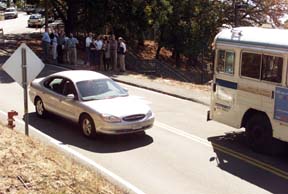 |
“We have worked to reduce the impact by adding spaces specifically to serve the people who park in the impacted area,” says Rich McClure, planner for the Facilities Department. “Such changes are never simple, nor are they taken lightly. The opening of Lawrence Road to two-way traffic creates a major overall benefit to the Laboratory, and we are doing the best we can to make sure the empoyees’ parking needs continue to be met.”
Rich McClure answers some of the frequently asked questions about the
new parking configuration.
Q: How many parking spaces — and of what kind — have been eliminated, and how many new ones are being created to replace them?
A: All parking spaces removed and created are general parking (yellow permit). The final tally is a net increase of 11 new spaces. An additional nine spa-ces along McMillan Road, which had been used for construction over the past two years, are being returned to parking.
Q: The roadside parking spaces being eliminated near the Z lot are used by many employees who work in the Building 50 and Building 70 complexes. How does the creation of new parking spaces in other areas affect those people?
A: Last spring we did a survey of vehicles parked in the spaces that were removed. Indeed, we determined that a significant number of those parking along the road beyond the “Z” lot work in the Building 50 complex. Because of this finding we incorporated a sub-project into the plan, which added parking spaces at the Building 51 EPB yard.
In addition, a number of replacement spaces were added right along Lawrence Road through the use of small retaining walls. The other spaces we created are adjacent to Buildings 10, 6, 17 and 4, to serve employees who work at other locations on the Hill.
Q: Will the additional spaces near Building 51 be available for general parking?A: The 14 new spaces at Building 51 are designated for general parking. As further space becomes available, we intend to add parking spaces to this lot.
Q: Will any additional spaces in the cafeteria lot be opened up to general parking?
A: We will monitor the situation over the next few weeks. We will work with the Parking Office to make a determination on whether to redesig some of the current Blue Triangle space near the cafeteria lot as general parking.
Further questions about the project may be directed to project engineer Steve Blair at X5927, SABlair@lbl.gov.
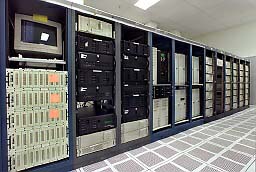 |
Eighty-two new servers and significant improvements in the overall computing and networking infrastructure will be added this fall to the Parallel Distributed Systems Facility (PDSF), a large computer cluster currently operated as a partnership between the Nuclear Science, Physics, and NERSC divisions. Computing power will be expanded by 57 dual-processor nodes, and storage capacity will be tripled.
The PDSF serves the data-intensive computing needs of international high energy and nuclear physics experiments at the world’s most powerful accelerator centers, including those at Brookhaven, CERN, Fermilab, and the neutrino detectors in Canada (SNO) and Antarctica (AMANDA).
“The large computing and storage capabilities of the PDSF play an essential role in helping researchers extract the physics from the terabytes of data that they produce,” said Lee Schroeder, director of the Nuclear Science Division.
Clusters are assemblies of commodity computers designed and networked to operate as a single system. The PDSF currently consists of 281 processors with a theoretical peak processing capacity of 155 gigaflop/s and a total storage capacity of 7.5 terabytes. When the current expansion is completed in October, the PDSF will have 395 processors, and the number of disk vaults will grow from 15 to 40, with a total 24 terabytes of shared storage.
In addition to the new servers and disk vaults, the expansion will include added memory for some computer nodes as well as upgrades to console servers, switches, networking cables, disk drives, software, and miscellaneous tools.
By David Gilbert
Ensconced under rocks, docks and boats, the lowly sea squirt passes its days benignly siphoning sea water through its tubular mouth, filtering out oxygen and plankton for sustenance. It is hard to believe that this primitive creature, a gelatinous blob that gets its name from its tendency to “squirt” when plucked from the water, is one of our more scientifically significant distant relatives.
Ciona intestinalis, as the squirt is formally known, is a cordate — that is, of the phylum Chordata, which includes all well-known critters with spinal chords: fish, amphibians, reptiles, birds, and mammals. For this reason, this early chordate has captured the imagination of the international genomics community and specifically a team of researchers at the DOE Joint Genome Institute’s Production Genomics Facility (PGF) in Walnut Creek.
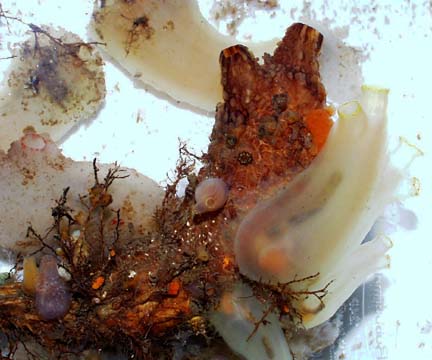 |
Ciona are kept in an aquarium at the PGF for use in functional genomics experiments. DNA has been extracted, cloned, and is currently being sequenced to unravel its genetic code. Ciona has joined the veritable menagerie of organisms that have united Homo sapiens, Mus musculus (house mouse), Fugu rubripes (Japanese pufferfish), Phanerochaete chrysosporium (white rot fungus) as well as a host of microbes into a diverse club membership of genomes the JGI has sought to tackle.
“At only 180 million base pairs of DNA, Ciona has the smallest genome of any scientifically useful chordate, and provides a good system for exploring the evolutionary origins of the chordate lineage, from which all vertebrates sprouted,” says JGI Director Trevor Hawkins.
Other attractive features of Ciona, besides its world-wide distribution and year-round accessibility, Hawkins says, is that it has cells that are easily visualized along with the organism’s developmental processes. “We have the tools to track gene expression in Ciona, and that, along with the complete genome sequence, will provide us with the blueprint for the genome-scale analysis of regulatory networks through the organism’s development. In this way, the squirt fits quite nicely into the DOE’s Genomes to Life (GTL) initiative.”
GTL is a 10-year program designed to use DNA sequences from microbes and higher organisms, including humans, as starting points for systematically tackling questions about the essential processes of living systems. The DOE offices of Biological and Environmental Research and Advanced Scientific Computing Research have formed a strategic alliance to meet this grand challenge. GTL will be the platform on which technological and computational resources will be assembled to identify and understand the underlying mechanisms that enable organisms to develop, survive, carry out their normal functions, and reproduce under myriad environmental conditions.
“Through Genomes to Life we are being tasked to advance the boundaries of genomics venturing beyond the characterization of such individual life components as DNA sequences, genes and proteins, toward a more comprehensive, integrated view of biology at a whole-systems level,” Hawkins says.
“In our quest to sequence and annotate the human genome we are taking a comparative approach,” says Dan Rokhsar, the JGI’s Acting Associate Director for Computational Genomics. “Several months ago we embarked on a partnership to sequence a portion of the mouse genome. We then branched out to Fugu — perhaps 450 million years separates those species from a common ancestor — to illuminate the common elements among vertebrates, and now to Ciona, to understand our common chordate ancestry. The advantage of moving away from human is both to allow the identification of conserved and therefore presumably functional genomic elements, and then to probe these functions experimentally in organisms like Ciona.”
Provided all goes as planned, Ciona’s genetic signature will be “in the books” shortly after the beginning of the new year.
On Wednesday, Sept. 26, EH&S Waste Management bestowed the 2001 Pollution Preventers Awards. The winners were honored for their contributions to the recycling and reuse of resources, the prevention of hazardous waste, and the dissemination of waste minimization information. Photo by Robert Couto
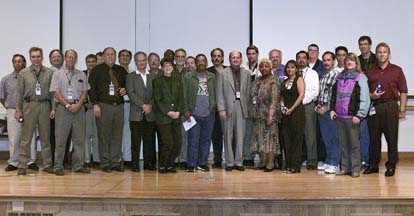 |
Rosemary Evanoff of the Computing Infrastructure Support Group will address the October meeting of the Mac User Group on Friday, Oct. 26, from 11 a.m to noon in Building 90-3148. Topics will include the process of selecting standards for computers, current support for Macs at the Lab, issues driving future support strategies and recommendations on future support. Questions and answers will follow. Refreshments will be provided by the Mac User Group.
More than 225 participants from the U.S. and abroad are expected to attend his year’s ALS Users’ Meeting, which will take place at Berkeley Lab from Monday, Oct. 15 to Wednesday, Oct. 17. This year’s extensive program of oral and poster sessions will feature recent advances in synchrotron-related research. Seven focused workshops covering topics such as protein crystallography, infrared spectromicroscopy, molecular environmental science, and materials science will take place on Tuesday and Wednesday.
Representatives from the following companies will be on site to exhibit the latest in synchrotron, vacuum, and other technical equipment: Pfeiffer Vacuum, Gammadata Scienta AB, VAT, Inc., X-Ray Instrumentation Associates , Varian Vacuum Technologies, Brush-Wellman Electrofusion Products, Nor-Cal Products, Inc., Bruker Axs, THT Group, Inc., Heat Wave Labs., Inc., Huntington Labs, MDC Vacuum Products Corp./Insulator Seal, Blake Industries, Inc., Applied Geomechanics, Inc., Kurt J. Lesker, Co., Oxford Danfysik, Roper Scientific, Inc., US, Inc.
All employees are invited to view the equipment displays in the exhibitors’ tent, adjacent to the ALS (Building 6) patio on Monday, Oct. 15, from 2:30 to 4:30 P.M., and Tuesday, Oct. 16, from 9 a.m. to noon.
For more information about the meeting, including agenda, workshop, and registration information, see the ALS Users’ Meeting Web pages at http://www-als.lbl.gov/als/usermtg.
Representatives of the Costco wholesale warehouse will be at the Laboratory for two days next week to explain membership benefits and register those who are interested. All Berkeley Lab employees qualify for membership in the program.
On Tuesday, Oct. 9, a Costco information table will be set up in the lobby of Building 937 in downtown Berkeley during the lunch hour. And on Wednesday, Oct. 10, representatives will be in the lobby of the main cafeteria of the Hill site from 11:30 a.m. to 1:30 p.m.
During the month of October, new members who sign up at the Lab will be offered a dozen muffins and a special coupon book, plus an extra month on their membership. Fees are $45 annually and include a free spouse/domestic partner card.
This Sunday, Oct. 7, the Lawrence Hall of Science will hold its own commemoration of the 100th anniversary of the birth of Berkeley Lab founder Ernest O. Lawrence — UC Berkeley’s first Nobel prize winner. The event will take place from 10 a.m. to 4 p.m.
Other events and special exhibits at the LHS in October include:
Optics Fair, Oct. 13
See beneath the surface of objects and explore the world unseen with the aid of microscopes, binoculars, and hand lenses. 12 - 1 p.m.
Family Math Workshop, Oct. 20
This free three-hour workshop (10 a.m. - 1 p.m.) will show you how to help your child with math homework. Features the award-winning math board game “Equate” and more. To register, email lhsstore@ uclink.berkeley. edu or call 510-642-1016.
Halloween Magic, Oct. 27
This year’s Halloween Party explores the wizardry found in the Harry Potter stories. Call LHS at 642-5134 to register. 6:30 - 9 p.m.
Scream Machines: The Science of Roller Coasters, Oct. 6 – Jan. 6
Activity stations reveal and explain the phenomena behind the screams and thrills of the roller coaster.
A-Maze-ing Maze, Oct. 20 – Nov. 25
Test your sense of direction by trying to find your way out of LHS’s oqn colorful A-Maze-ing Maze, constructed out of colorful 8-ft-high panels.
One of the most popular events at Berkeley Lab, the annual Runaround, will be held next Friday, Oct. 12. The 3 km race starts at noon at the firehouse and finishes at the cafeteria.
Everyone is encouraged to participate, and ample time will be allowed for all participants to finish the course. Prizes are given for costumes and other fun categories.
The Runaround website (http://cfi.lbl.gov/~derenzo/runaround/) includes a downloadable course map, results for the past 15 years, safety tips and more.
As in past years, a noncompetitive Bikearound will be held starting at 11:30 a.m. at the firehouse.
For more information contact Steve Derenzo at X4097.
The Laboratory has initiated its first wall-to-wall inventory in four years. This means that each of the more than 16,000 assets with a bar code label on them must be inventoried. We will begin this process with division property representatives making the first pass with the new bar code readers. Our goal is to complete this step by Nov. 1. The next step will involve contacting the property custodian for those assets not inventoried to verify their actual location, and then conducting an inventory of them.
In case you would like to review the lists of assets under your responsibility, you may access the Property Management website at http://defiant.lbl.gov/ams/ and select the report titled "Property Lookup by Custodian." To find out who your property representative is, look up the Property Management website at http://www.lbl.gov/Workplace/Property-Management/, then select "Division Property Personnel" (next to the telephone icon). For further assistance call the Property Management office at X5151.
TEN YEARS AFTER THE 1991 EAST BAY HILLS FIRE
Rich McClure on Vegetation Management
Plan
12:00. Bldg. 50 auditorium
COSTCO INFORMATION TABLE
12 – 1 p.m., Bldg. 937 (downtown)
COSTCO INFORMATION TABLE
11:30 a.m. – 1:30 p.m., cafeteria lobby
NEW EMPLOYEE ORIENTATION
Starts at 8:30 a.m., Bldg. 50 auditorium
XXIV ANNUAL RUNAROUND
12 p.m., starts at Firehouse
Send us your announcements
Announcements for the General Calendar and Bulletin Board
page may be sent to MSFriedlander@lbl.gov. Seminar & Lectures items
may be mailed to currents_ calendar@lbl.gov. You may also fax items to
X6641 or mail them to Bldg. 65B. The deadline for the Oct. 26 issue is
5 p.m. Monday, Oct. 22.
DEPARTMENT OF PHYSICS COLLOQUIUM
Experiments in Quantum Feedback
Speaker: Hideo Mabuchi, Cal Tech
4:30 p.m., 1 Le Conte Hall
LIFE SCIENCES DIVISION SEMINAR
Tissue Specificity and Epigenetics:
Beyond the Nucleus
Speaker: Mina J. Bissell, Director, Life Sciences Division
4 p.m., Bldg 84, Rm 318
PHYSICS DIVISION RESEARCH PROGRESS MEETING
CESR-C: Glueball Hunters Get a Life
Speaker: Michael Chanowitz, Physics Division
4 p.m., Bldg 50A-5132
CENTER FOR BEAM PHYSICS SEMINAR SERIES
Resistive Wall Impedances of Multilayer
Elliptical Structures
Speaker: Alexey Burov, FNAL
10:30 a.m., Bldg 71 Albert Ghiorso conference room
15TH ANNUAL EMILIO SEGRÈ LECTURE
How Do We Think So Fast?
Speaker: John J. Hopfield, Princeton University
5:45 p.m., George C. Pimentel Hall
LIFE SCIENCES DIVISION SEMINAR
The Drosophila Blastoderm as a Model
System for the Functional Genomics of Development
Speaker: John Reinitz, SUNY at Stony Brook
4 p.m., Bldg 84, Rm 318
PHYSICS DIVISION RESEARCH PROGRESS MEETING
Probing CP Violation Beyond The Standard
Model
Speaker: Justin Albert, Princeton
|
Date |
Course |
Time |
Building |
|
|
10/3 |
EHS 116 |
First Aid |
8:30 – 12:00 |
48-109 |
|
10/9 |
EHS 10 |
Introduction to EHS at LBNL |
8:30 – 10:15 |
50 aud |
|
10/10 |
EHS 123 |
Adult CPR |
8:30 – 12:00 |
48-109 |
|
10/10 |
EHS 210 |
Hoist Training |
10:30 – 12:00 |
51-201 |
|
10/11 |
EHS 60 |
Ergo for Computer Users |
10:30 – 12:00 |
51-201 |
|
10/12 |
EHS 400 |
Radiation Protection-Fundamentals |
9:00 – 12:00 |
51-201 |
|
10/15 |
EHS 330 |
Lead Hazard Awareness |
1:30 – 2:30 |
51-201 |
|
10/16 |
EHS 154 |
Building Emergency Team |
9:00 – 11:00 |
48-109 |
|
10/16 |
EHS 275 |
Confined Space |
9:00 – 11:00 |
51-201 |
|
10/16 |
EHS 274 |
Confined Space Retraining |
11:00 – 12:00 |
51-201 |
|
10/17 |
EHS 530 |
Fire Extinguisher |
10:00 – 11:30 |
48-109 |
|
10/17 |
EHS 280 |
Laser Safety |
1:00 – 4:00 |
51-201 |
|
10/17 |
EHS 135 |
Earthquake Safety |
3:00 – 4:00 |
48-109 |
|
10/18 |
EHS 260 |
Basic Electric Hazard Awareness |
9:00 – 10:30 |
51-201 |
|
10/18 |
EHS 61 |
Ergo for Workstation Evaluator |
2:00 – 4:30 |
51-201 |
|
10/19 |
EHS 432 |
Radiation Protection-Lab Safety |
9:00 – 12:00 |
51-201 |
|
10/22 |
EHS 348 |
Chemical Hygiene Safety |
9:00 – 12:00 |
51-201 |
|
10/22 |
EHS 231 |
Compressed Gas Safety |
1:30 – 4:00 |
51-201 |
|
10/23 |
EHS 60 |
Ergo for Computer Users |
9:00 – 10:30 |
51-201 |
|
10/23 |
EHS 735/ |
Biosafety/Bloodborne Pathogen |
1:30 – 2:45 |
51-201 |
|
10/23 |
EHS 730 |
Medical Biohazardous Waste |
2:45 – 3:30 |
51-201 |
|
10/24 |
EHS 210 |
Hoist Training |
10:30 – 12:00 |
51-201 |
|
10/25 |
EHS 604 |
Hazardous Waste Generator |
9:00 – 10:30 |
51-201 |
|
10/25 |
EHS 622 |
Radioactive-Mixed Waste Generators |
10:30 – 11:30 |
51-201 |
|
10/30 |
EHS 256 |
Lockout/Tagout |
10:00 – 11:30 |
51-201 |
* Includes EHS 392/405, followed by the orientation. Please arrive at 8:15 for sign-in.
For more information or to enroll, contact Valarie Espinoza at VMEspinoza@lbl.gov or enroll via the Employee Self Service website ayt https://hris.lbl.gov/self_service/training/index.html. Preregistration is required for all courses except EHS 10 (Introduction to EH&S). Times and locations are subject to change. For a full, updated schedule of EH&S training sessions see http://www-ehs.lbl.gov/schedule/.
UC Berkeley Department of Physics Colloquium
Monday, Oct. 29 * 4:30 p.m. * Le Conte Hall
Lawrence & Fermi: A Joint Centennial
John Heilbron, Worcester College, Oxford
Ernest Lawrence and Enrico Fermi, both born in 1901, were dominant figures in nuclear physics in the decades both preceding and following World War II. The lecture will trace their friendly competition during the 1930s, their parallel work in the Manhattan project, and their divergent postwar paths until their untimely deaths in the 1950s.
Remembrances of Ernest O. Lawrence and his Laboratory After World
War II
Wolfgang K. H. Panofsky, Director Emeritus, SLAC
The talk will cover the creative period at the UC Radiation Laboratory immediately after the end of World War II. The speaker will discuss personal experiences and share episodes from Lawrence’s leadership.
Photo: (L) EOL; (R ) Fermi.tiff
‘98 SATURN SL2, 4 dr, dk green, 16K mi, economical, factory alarm, keyless entry, auto, reg service/maint paid through 4/2003, $10,500, Michael, X4745, 420-7022
‘97 KIA SEPHIA, simple & reliable, 5 spd, sunroof, 49K mi, $4,500/bo, Alexei, X7521
‘95 MAZDA MPV, beige, 75K mi, single owner, records avail, very good cond, $6,200/bo, Eddy, X5072
‘93 FORD ESCORT LX, 4 dr hatch, red, auto, 1.9L eng, 114K mi, new tires & brakes front/rear, timing belt changed, front end repaired from a fender bender some time ago, $2,200/bo, David, 642-5589 days, 642-5589 eve
‘91 TOYOTA CAMRY DX, 72K mi, 1 owner, ac, pwr win/locks, gray, $3,500, Margaret, X5261
‘91 FORD TAURUS GL 4 dr se-dan, silver blue, 3.0 L eng, 6 cyl, auto, all pwr, tilt wheel, am/fm/ cass, driver-side air bag, ac, alarm, under 95K mi, runs great, $1,800/ bo, Leon, X2533
‘90 TOYOTA CAMRY LE station wagon, V6, all pwr, wht, good cond, $4,500, Inna, X2419, (925) 933-1747 eve
‘89 HONDA Lxi, 230K mi, 4 dr, 5 spd, reliable, Bill, X7385, 595-9070
‘88 MAZDA 626, turbo 5 dr, auto, pwr steer/win, sliding sunrf, 4 cyl 2.2 liter, 111K mi, front wheel drive, all disk brakes, well maint, records avail, smogged, $2,00/bo, Rupert, X5680, (925) 212-7394
‘88 ACURA LEGEND, dk blue, exc cond, alarm, vogue rims, top quality stereo w/ remote, tinted win, must see to appreciate, $7,050/bo, Mary, 532-2966
‘86 FORD RANGER extended cab, 4 wd, auto, am/fm/cass, camper shell & carpet kit, high miles but runs/looks good, $1,800/bo, Martin, X4371, (925) 370-6002
‘85 JEEP CHEROKEE, 260K mi, red, 2nd eng, new starter, water pump, carburator, tires, radiator, & clutch, $2,000, Artur, 528-8395
‘92 YAMAHA XJ 600 Seca II, 37K mi, black, 599 cc inline four, Genesis-design 16 valve, four 26 mm Mikuni carbs, 6 spd, adj rear shock, $1,900, Doug, X7595
BERKELEY 1 bdrm/1 bth furn condo in exc bldg close to Piedmont Ave, avail 10/15 - 6/15, $950/mo, must see to appreciate, Eileen, 595-9092
BERKELEY southeast, 2 bdrm apt in duplex, hardwd floors, firepl, w/d, many built-ins, $2,300/mo, Lara, lagundel@lbl.gov
BERKELEY B&B, close to shuttle, 1 garden cottage room & 1 lge room avail 10/1, 1 person per rm, $950/mo or $325/wk, 2 wks min, Hellen, 527-3252, Rachel, X6262
BERKELEY, Elmwood distr, quiet visiting scholar for room rental avail late Oct, 2 bdrm flat shared w/ Lab employee & short-haired cat, unit part of 4-plex, 10 min walk to campus, furn rm w/ hardwd floors, shared bth/kitchen/lvg rm, cable, onsite w&d, close to pub trans & shops, off-street parking may be avail for add’l charge, longer term rental pref but short-term possibile, $750/ mo, Susan, X5437
CENTRAL BERKELEY nice furn rooms $300/wk or $930/mo, kitchen, laundry, TV, DSL avail, walk to shuttle & shops, Jin or Paul, 845-5959, jin.young@juno. com, Paul X7363
KENSINGTON, garden apt, fully furn, spacious 1 bdrm/1 bth, TV, VCR, stereo, microwave, linens, utensils, garden, off-street parking, friendly & safe neighborhd, close to pub trans & park, not far from Lab, $950/mo, Chris, 524 9655, ckafitz@aol.com
LOWER MONTCLAIR house for rent, quite street, 2 mins from hwy 13, 2-1/2 bdrm, large rec rm, 2 fireplaces, 2 bth, dog possible. $3,000/mo incl util, avail now, Jay, X5244
NORTH BERKELEY 1 bdrm/2 flr garden cottage, approx 500 sq ft, view of garden, skylights, tile flrs, very light, sunny, clean, sm upstairs bdrm w/ view of hills, priv entr, offstreet parking, close to bus/BART/shops, fully furn, 1 yr lease pref but neg, $l,350/mo + util, first/last + $700 dep, no smoking indoors, pets neg, avail 10/1, Janet, 527-0210, najet@ earthlink.net
NORTH BERKELEY, beautiful, light, airy, furn studio cottage avail for immediate sublet, female or possibly couple, no smoking, close to Lab, campus, Gourmet Ghetto, shares well-maint backyard w/ main house, length of stay neg up to 6 mos, $1,000/mo + sec dep, Bill, X5229
OAKLAND Diamond distr, 1 bdrm apt, fully furn, close to bus/ shop, month-to-month sublet, $750/mo, mature person, student pref, Mary, X6198
ORINDA/BERKELEY HILLS, 1 bdrm apt, 10-15 min from Lab, garage, fireplace, deck, quiet woody view, 6' built-in desk, connections for small w&d, $1,100, avail about 10/7, James, mtdo42@ jps.net
SAN FRANCISCO sublet avail 11/1-1/31, Dolores Park, close to BART, lge furn 2 bdrm Victorian flat, hardwd flrs, bay win, walk-in closet, storage space, garden, close to Valencia corridor for shopping, restaurants, $1,750/mo, Lenny, (415) 282-1980, loliker@ lbl.gov
PHD STUDENT from the business school looking for a studio/ 1bdrm, considerate & mature non-smoker, Barbara, bukhvalo@ haas.berkeley.edu, 643-1423
AIR HOCKEY TABLE, 3.5’ x 6’, good cond, $40, Alexander, (925) 937-2318
BOOKCASES, two, light oak, exc cond, 5’10"h x 3’w x 9"d, $50/ea, Robert, 642-2156, 527-2937
COLLECTIBLE BARBIES (Coca Cola, Holiday Jewel, Evening Extravaganza, Autumn, Avon Exclusives, etc), prices vary, certific’s of authenticity, box never opened, Lisa, X5314, (925) 906-9786
OAK DINING TABLE, 5' x 3' & 4 chairs w/ upholstered seats, $150; 2 teak bookshelves, 6'x30"x 11.5", $50/ea, Rosemary, (925) 229-4275
STUDENT DESK, small, $25; matching 4 drawer dresser, $35; pool or spa, Mitra ma 100 water filter w/ 2 cartridges, $50, James, (925) 831-9958
TAHOE KEYS at S. Lake Tahoe, 3 bdrm house, 2-1/2 bth, fenced yard, quiet, sunny, close to attractions, priv dock, great view, $175/ night, 2 night min, Bob, (925) 376-2211
FOUND: near Bevatron, pendant on gold-colored cable braided 28" chain, Gerald, X7165
Ads are accepted only from LBNL employees, retirees, and onsite DOE personnel. Only items of your own personal property may be offered for sale.
Submissions must include name, affiliation, extension, and home phone number. Ads must be submitted in writing via e-mail (fleamarket@lbl.gov), fax (X6641), or delivered/mailed to Bldg. 65B.
Ads run one week only unless resubmitted, and are repeated only as space permits. They may not be retracted once submitted for publication.
The deadline for the Oct. 19 issue Thursday, Oct. 11.